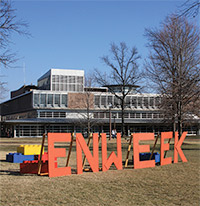Latest News
February 20, 2014
It’s mid-February, much of the country is getting pummeled by a series of winter storms, and many schools are on break for President’s Week vacation. So what, you might ask, does this third week of February remotely have to do with design engineering?
It turns out, quite a lot. National Engineers Week, held this year from February 16-22, is a week-long celebration, launched in 1951, to focus attention on the role of engineers in society. Started by the National Society of Professional Engineers, the event is observed by more than 70 engineering, education, and cultural societies with participation from more than 50 corporations and government agencies.
President Washington is considered as the nation’s first engineer, notably for his survey work. — Wikipedia
Not only is National Engineers Week designed to cast the spotlight on the role of engineers in society, it’s grown into a full-fledged, nationwide outreach program that encourages corporations, academia, and professional engineering societies to emphasize the importance of learning science, technology, engineering, and math (STEM) to students from K-12 and beyond.
DiscoverE is the sponsor of National Engineers Week, which this year is focused on the theme of “let’s make a difference.” DiscoverE says most American kids and adults don’t adequately understand the role of engineers or the discipline. “They don’t know that engineering is a collaborative, creative process that makes a difference in all of our lives—from advances in life-saving medicines to more productive crop yields to clean drinking water,” reads the description on the DiscoverE Web site.
The “Let’s Make a Difference” theme is designed to encourage engineers, students, and others in the field to share their expertise and enthusiasm by volunteering in classrooms or by hosting a public event. So, for example, local museums like the Buffalo Science Museum, are hosting programs for kids—everything from how to build a robot to designing a wired dollhouse to spark interest among girls. Universities like Penn State, University of Delaware and Syracuse University, among many others, are hosting programs to promote their engineering curriculum on campus as well as to encourage engineering students to mentor students in lower K-12 grades.
All of this focus on STEM is critically important. According to 2012 data from the Organization for Economic Co-operation and Development, the United States ranks 26th in the world in math competency and 21st in the world for science competency among high-school students—figures academia, business, and even President Obama want to see rise exponentially.
“There is a widening gap between the demand for skilled, knowledgeable workers in science and engineering and the number of students pursuing degrees in these fields,” notes Dave Wilson, director, academic programs at National Instruments. “Furthermore, students who do obtain engineering degrees often experience a major disconnect between the concepts they have learned in their studies and the practical applications to real-world problems they will see later in their careers. To address these concerns, NI strongly believes in providing engaging hands-on learning experiences for students of all ages.”
NI also believes in the value of programs like National Engineers Week to advance the cause. ” National Engineers Week is a great way of reminding people of the importance of engineering and how engineers contribute to society, but more importantly, it inspires students to pursue degrees and careers in the STEM fields,” he says.
Getting students to see the value in what engineering brings to the workforce is a key piece of the National Engineers Week story. Recent studies have found that only 4% of the nation’s workforce is composed of scientists and engineers, but this group disproportionally creates jobs for the other 96%.
Knovel, which integrates technical information with analytical and search tools, released an infographic for National Engineers Week that highlights some of the benefits of choosing an engineering career. Aerospace and chemical engineers are the most highly paid, according to Knovel, with the Northern California cities of San Jose, Sunnyvale, and Santa Clara, and Texas cities of Houston and Midland among the top paying metropolitan areas.
And, so we don’t leave our civil engineering brethren out of the National Engineers Week celebration, check out this infographic from the New Jersey Institute of Technology, which highlights how important engineers were to bringing the 2014 Winter Olympics to Sochi, Russia.
Watch this video to hear a panel of engineering professors and professionals wade in with their perspective on the importance of engineering and National Engineers Week to STEM education.
Subscribe to our FREE magazine, FREE email newsletters or both!
Latest News
About the Author
Beth Stackpole is a contributing editor to Digital Engineering. Send e-mail about this article to [email protected].
Follow DE






